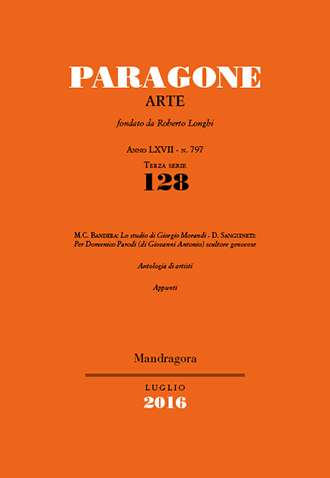Paragone Arte 128

Anno LXVII – Terza serie – Numero 128 (797) Luglio 2016
Maria Cristina Bandera: Lo studio di Giorgio Morandi
Daniele Sanguineti: Per Domenico Parodi (di Giovanni Antonio) scultore genovese
ANTOLOGIA DI ARTISTI
Un ritratto di Jacopo Zucchi ‘à la manière de’ Scipione Pulzone (Alessandro Cecchi)
APPUNTI
Nuovi documenti sulla casa e sulla bottega del Botticelli (Alessandro Cecchi)
SUMMARY
MARIA CRISTINA BANDERA
The article enhances our understanding of the place in which Giorgio Morandi worked throughout his life, the small studio in his house in Via Fondazza in Bologna, now called the Museo Casa Morandi. The rarefied, magical atmosphere of his atelier, with his celebrated ‘dusty’ objects, captured the imagination of a restricted group of critics, writers and film directors – including Giuseppe Raimondi, Luigi Magnani, James Thrall Soby, Lea Quaretti, Arnaldo Beccaria, John Rewald, and Valerio Zurlini – who were given access to it by Morandi himself, prompting reflections and emotional insights. These accounts are re-read through a direct observation of the space that hosted the tirelessly industrious and sensitive painter.
DANIELE SANGUINETTI
A parallel reading of available sources and new documents casts a more accurate light on Domenico Parodi, the Genoese sculptor who had the same name as the son of Filippo Parodi, with whom he is often confused. New observations, above all regarding his training, emerge from a comparison of the two editions of Carlo Giuseppe Ratti’s biography, also with respect to that of Filippo Parodi, who collaborated with him and lived with him in Rome, according to Ratti. It was in Rome that Domenico absorbed the “far grande” approach he had seen in the workshops of the Bernini circle, and which he put into practice more than Filippo himself on his return to Liguria, producing works in both marble and wood. A review of his oeuvre, including the unpublished Madonna in Savignone (1690), and the revised dating of the Algardi-inspired Baptism in the church of Santa Maria delle Vigne, Genoa (1690-1691, not 1697), reveals a consistent evolution in the sculptor’s rhetorical language.
ALESSANDRO CECCHI
The author proposes that a portrait of Cardinal Ferdinando de’ Medici, formerly attributed to Scipione Pulzone, is by Jacopo Zucchi, Florence, Galleria Palatina.
ALESSANDRO CECCHI
In the wake of his earlier research, the author publishes and discusses new documents relating to the house and workshop of Sandro Botticelli, in one of which he recognizes the painter’s handwriting.
